Model Railway Digital Command Control (DCC)
Author "pete12345" (forum member)
Please note: Electronics can be dangerous!! Please follow the instructions
provided with any electronic devices. This website cannot be held
responsible for injury, howsoever caused from the use of this information.
If you are unsure about anything please ask a qualified electrician for
help.
What is DCC?
The fundamental question: what exactly is this fancy digital system? There’s a
long answer and a shorter one. To avoid confusion, I won’t go into any of the
techie stuff about how the electronics of DCC work because unless you’re
building your own system, it isn’t really relevant.
The best way to understand DCC is to think of a full size electric railway,
such as the London Underground. Power is constantly supplied to the trains by
conductor rails. The train driver on board each locomotive is then able to use
this power to regulate the train’s speed by controlling how much goes to the
traction motors.
In model form, the principle is the same. The difference is that instead of a
miniature driver, we fit each loco with a small electronic decoder, which
receives power directly from the track. Unlike conventional DC systems, this
power is always on. This way, the locos are all separated from each other.
Instructions are sent down the track by the controller and picked up by each
decoder. If the command is intended for it, a decoder will respond accordingly,
such as to increase its speed or switch on the headlights. If not, the commands
are ignored and the loco carries on whatever it was doing. All locos can
therefore be controlled independently of each other. With DCC, you drive the
train and not the track.
Some popular DCC myths and misconceptions busted:
1) DCC means computer control.
Not necessarily. While DCC is ideal for computer control (as the DCC controller
is already working in binary code, a simple interface is all that’s needed for
it to ‘talk’ to a PC) you don’t have to touch a computer to use DCC. You can
(and most users do) control trains manually with a controller.
2) ‘Wiring for DCC’
This one just won’t go away. The prospect of ‘wiring for DCC’ often scares
would-be newcomers with the thought of doing miles of complex wiring because of
the more complex technology. Nothing could be further from the truth. Because
you are controlling individual locos rather than sections of track, you don’t
need to set up isolating sections just to hold one train stationary while you
move another. The loco itself is isolated electronically. All we need to do is
power the track, avoiding short circuits.
There’s still wiring to be done, as I’ll show in following chapters, since we
need to ensure the power gets to all parts of the layout without causing any
short circuits. But it ranges from slightly simpler to a lot simpler than a
comparable DC layout. ‘Wiring for DCC’ is nothing more than ‘wiring for DC’ with
bits left out.
3) ‘Two wire control’
Here’s one you’ll see in manufacturers catalogues. This one is semi-true,
actually, since there are only two main wires to the layout. However, on
anything but the simplest layouts, you’ll need extra feeds here and there to
ensure continuity. Rather than wiring them all to a central panel though, all
these feeds connect into the two main wires. So while there are only two wires
leaving the controller, you will expect to see more than two connection points
to the track.
4) ‘Programming’
Another myth that sparks fear and confusion. What is wrong with this one is the
choice of word. ‘Programming creates mental images of computers, complex
program-writing and lots of effort and head scratching.
The fact is, you don’t have to program anything to use DCC. Decoders come from
the factory ready set up, and after installing into a loco will work right away.
All you really need to do (unless you will only use one loco) is to allocate
each loco a unique ‘address’ or running number (the default is usually 3). This
enables the controller to 'talk' to each loco separately. However, this can be
done with a few quick key presses and is very simple to do. After that, you can
leave things how they are from the factory (which most of us are happy with
under DC anyway)
Of course, there are lots of things you can alter if you want, but it’s all
optional. You can set up the maximum speed to something more realistic, or play
around with the acceleration rate. If you just want to get something going
though, you don’t need to bother with any of it.
For the sake of clarity, I’ll be using programming here, but feel free to read
it as ‘setting up’, ‘configuring’ or whatever word you want.
DCC on DC?
Questions on DCC often get asked about running a DCC fitted loco on a DC layout,
and vice versa.
DCC decoders are designed so they will operate on DC layouts (though this can be
disabled if you wish) On detecting the DC supply, the loco will respond as if it
were a DC loco.
The reverse is not as simple. While many systems allow the running of one
unconverted loco on DCC control (usually on address 0) the control method is
rather crude. It works by 'stretching' the signal to give a DC bias. However,
you are still running a DC loco on what is effectively an AC supply. This will
cause motors to heat up sometimes burn out.
In short: DCC locos work fine on DC, DC locos are not recommended for use on DCC
layouts.
DCC Controllers(manufactures descriptions)
Hornby - DCC Controller 'Select' (R8213)
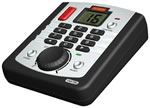 |
"The Hornby Select digital
controller is the perfect way to enter the digital world
of model railways. Each locomotive can be coded with up
to 99 levels of acceleration or deceleration speed
(inertia). The LCD display screen of the Select shows
the number of the loco or accessory which has been
selected. Power is through a standard wall mounted
transformer which supplies 1 amp 15V DC power to the
track; a larger 4 amp transformer is available which
will provide additional power to the track for more
locomotives to be run at the same time."
|
and 'Elite' (R8214)
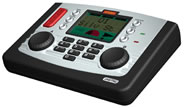 |
"For those who wish to take their train control to a new
and advanced level, the Hornby Elite is
the ideal companion. Capable of answering the needs of
most railway layouts, this advanced unit with twin
control and wide function LCD screen can carry 255
registered locomotive addresses and the same number of
accessories, plus a USB portal for linking to a personal
computer. Once inputted and assigned, the unit will also
display the names and running numbers of locomotives, as
well as train direction, speed and function indicators.
A clock is also included on the display which can be set
to real time or up to 10x faster. The Elite is supplied
with a 4 amp transformer which is capable of providing
enough power to run approximately eight locomotives at
any one time."
|
Bachmann - EZ Command DCC Controller (Catalogue No. 35-500)
 |
"E-Z COMMAND allows the
operator to digitally control speed, lighting and
direction of multiple locomotives. Unlike other
complicated digital command control (DCC) systems, E-Z
COMMAND provides simple and straight forward digital
operation of your layout.
-
8 function buttons for control of specialist decoder
-
Simple on-track programming
-
Plug-in wiring
-
NMRA Standard DCC"
|
and Dynamis

Dynamis Review
(Click here)
|
"E-Z Command Dynamis allows
the operator total freedom by integrating advanced infra
red wireless technology into an affordable and powerful
Digital Command Control System. Using a unique toggle
style joystick both speed and selection of locomotive
are controlled. A backlit LCD screen with graphical
interface and easy to use menu buttons make programming
of CVs and operation of the unit is simplicity itself.
Locomotives can be recalled by either selecting the
locomotives by Name or Number and both 2 and 4 digit
addressing is supported. The 10 function buttons allow
for simple One Touch Operation allowing for different
sounds and lighting to be operated. In addition by
simply selecting A or B bank on the menu button you can
operate decoders which support up to 20 functions."
|


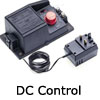






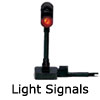

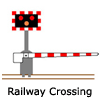




|






